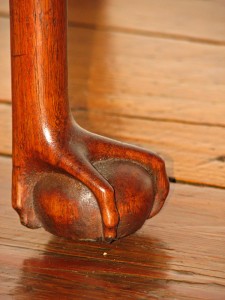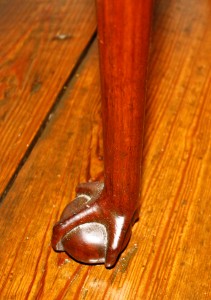We may receive a commission when you use our affiliate links. However, this does not impact our recommendations.
 Over on the Chris Schwarz blog, some of the people commenting on his review of Furniture in the Southern Style mentioned one of the photos in the introduction, and the reference to it being a misrepresentation of a ball and claw foot. I thought it would be a good idea to post the photo in question. We didn’t have room for more photos of this piece, and we assumed that the picture was enough to convey the idea without additional text. Perhaps we were too close to the subject and should have explained more about what the staff at MESDA referred to as “the Chicken Foot table”. As you can see, this is a good attempt at a ball and claw foot, but it is unusual in its form. To be specific, the leg is too straight to gracefully form the foot, and the ball is far from round, looking a bit squashed under the weight of the leg.
Over on the Chris Schwarz blog, some of the people commenting on his review of Furniture in the Southern Style mentioned one of the photos in the introduction, and the reference to it being a misrepresentation of a ball and claw foot. I thought it would be a good idea to post the photo in question. We didn’t have room for more photos of this piece, and we assumed that the picture was enough to convey the idea without additional text. Perhaps we were too close to the subject and should have explained more about what the staff at MESDA referred to as “the Chicken Foot table”. As you can see, this is a good attempt at a ball and claw foot, but it is unusual in its form. To be specific, the leg is too straight to gracefully form the foot, and the ball is far from round, looking a bit squashed under the weight of the leg.
This was one of the unusual pieces that we saw, and to our eyes it looked as though the maker may not have ever seen a ball and claw foot in person, but was working from a description. Or he may have been working from memory, and a few of the details didn’t come to mind.
 Here’s a view from a different angle and further away, and it shows the shape of the leg a little better. One of the commenters suggested that maybe we were picking on the original maker, that maybe he had the form correct and the guys from Philadelphia, Newport and New York didn’t know what they were doing. It really isn’t a matter of right or wrong, it’s about the usual and the unusual, and the reasons why things are similar to a point and then diverge.
Here’s a view from a different angle and further away, and it shows the shape of the leg a little better. One of the commenters suggested that maybe we were picking on the original maker, that maybe he had the form correct and the guys from Philadelphia, Newport and New York didn’t know what they were doing. It really isn’t a matter of right or wrong, it’s about the usual and the unusual, and the reasons why things are similar to a point and then diverge.
That’s what we tried to do with the book, look at period furniture from a new perspective and examine pieces that would reflect what people who weren’t fabulously well-to-do had in there homes two centuries ago. Some things take more than a quick look, and any book worth reading should make you stop and think at least a time or two.
Here are some supplies and tools we find essential in our everyday work around the shop. We may receive a commission from sales referred by our links; however, we have carefully selected these products for their usefulness and quality.









Maybe it’s really a pheasant or a turkey leg. Remember Ben Franklin (of Boston and Philadelphia) wanted the turkey as our national symbol. The turkey is not aggressive like an eagle, but experience these days with wild turkeys everywhere, proves that they are not to be messed with either, and like the US – more or less peaceful until provoked. Instead of a ball, maybe it is an egg. Depending on when it was made (I have the book but not handy) it might be a parody of the union eagle.
I have often thought–without the input of the original craftsman, you don’t know the actual intention. The misshaped ball, and the sraight legs could have been his way of thinking “outside the box”, while maintaining structural integrity of the piece. If he were still around, he may have told you “I meant for it to be like that”.
I recently praised the quality of your magazine to one of your competitors… But silly grammar mistakes are tickling my non-native English language origin… “weren’t fabulously well-to-do had in there homes …”
I’m one of the people who commented on Chris’ blog concerning the lack of explanation accompaning the photo.
So thanks for posting this. I actually hadn’t noticed how straight the leg was. That comment, combined with the extra photo, completes the thought for me.
Chuck
Here’s an idea: Not every Ancient and Honorable woodworker was to be Venerated. Some were good, some were great and some were hacks. Some may have farmed out the carving and some may not have. Who knows? Some pieces of furniture survived because they weren’t caught in one of the many fires that destroyed towns and cities during the Civil War.
De gustibus non disputandum es. Beauty is in the eye of the beholder. I could go on, but we each have our own way of determining what is appealing (and what is not). As Robert points out, there is most definitely some agreement on what is usual (and what is not). And the chicken leg is unusual. Heck, the staff at MESDA wouldn’t have come up with a nickname for it if it wasn’t unusual. And I’m not piling on country furniture, either. There are horrible examples of ball-and-claw feet from every region. I generally don’t care for those from New York. Most of the less attractive feet do not end up in the really famous collections and museums, bring the top prices at auction, or become centerfolds in coffee table books.
Without seeing the whole piece, this table leg looks like it was a Queen Anne leg that was turned on two centers, rather than sculpted. But instead of turning the usual pad foot, the maker carved a ball-and-claw. For all we know, he might not have wanted to, but when a customer insists, you charge them for extra carving.
It’s human nature to decide what is Good Better or Best. Even if the rest of us humans don’t agree.
I sort of like it. I can see how the entire piece may not be very gracefully. I do have a novice question.
I wonder if you couldn’t describe the Philadelphia Ball and Claw foot as a “misrepresentation” of the Oriental form.
Goodness, has the king no clothes…..
The best of Philly, Newport, and NY furniture was more refined (another way of saying “better”, no?) than country vernacular furniture. In general, if you had the money that’s the furniture you bought.
–Bill
Forest, VA
Or maybe that those surviving pieces are those belonging to the wealthy who could take care of them and those few surviving of the less wealthy are few and far between, hence the rarity of the variations on the ball and claw foot. For anyone to say this is right and that is wrong is really sort of short sighted.
Who’s to say a Philly or Newport or NY piece of furniture is better than a piece of vernacular furniture?